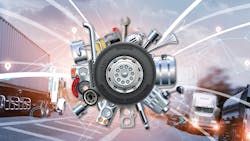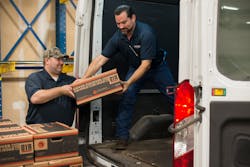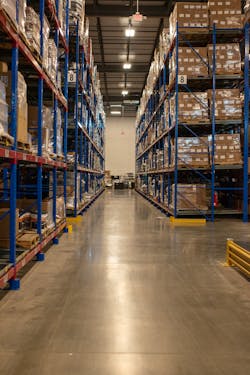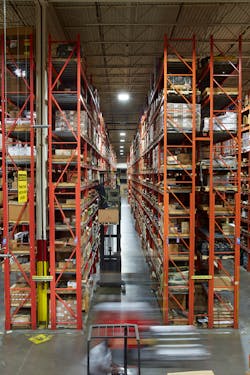When American Trucking Associations’ Technology & Maintenance Council reported during its 2022 annual meeting that parts costs are on the rise, it wasn’t much of a surprise to fleets. According to the latest quarterly Decisiv/TMC North American Service Event Benchmark Report, between the third quarter and Q4 2021 average parts costs rose 2.7%. Comparing Q4 2021 with data from Q4 2020, parts costs jumped 8.8%.
The reasons behind those increases were hardly surprising. Not only is the North American economy experiencing record inflation, supply chain issues are driving up parts prices as well. And perhaps impacting the need for more parts quite significantly is the need to keep vehicles in service longer as fleets await production of new and replacement equipment to return to pre-pandemic levels.
To offset higher prices, fleets are employing new approaches to choosing and sourcing the right replacement parts. One alternative, for example, is remanufactured and rebuilt components from manufacturers.
However, in a commercial vehicle parts aftermarket with a large number of suppliers, making decisions can be confusing and fraught with pitfalls. The wrong choice comes with the risk of premature part failure, leading to high costs for roadside assistance, potential vehicle damage, and increased downtime that impacts carrier revenue and profitability.
Reman vs. rebuild
If choosing the right replacement part is important at all times, it is especially so when selecting remanufactured and rebuilt components. To assist fleets in that market, the Bendix Commercial Vehicle Systems’ Tech Tips series offers guidance on what to ask suppliers and information on the differences between remanufacturing and rebuilding.
Understanding the distinction between remanufacturing and rebuilding is key, according to Bendix. A remanufacturer always replaces or repairs a core’s components to bring the part up to original equipment manufacturer (OEM) specs. In addition, remanufacturers always replace certain components—referred to as wear components—with new versions.
“Delivering quality along with a reduced replacement cost is what genuine remanufacturing is ultimately about,” noted Richard Nagel, Bendix director of marketing and customer solutions, Aftermarket and Air Supply. “By comparison, when a rebuilder disassembles the core of a product for reuse, they don’t necessarily replace the components with new ones or bring the product back to OEM specs. Rebuilders may simply clean or repaint components, and even if they do replace them, they may not have full access to OEM-quality parts, so you’re rolling the dice.”Manufactured Again Certification can help end-users determine which products come from a true remanufacturer, Bendix added. The program is overseen by MERA—The Association for Sustainable Manufacturing and employs criteria that align with the internationally recognized quality management standard ISO 9001 and IATF 16949, one of the automotive industry’s most widely used quality standards. To receive Manufactured Again Certification, remanufacturers are required to submit third-party evidence of conformance.
Mark Holley, Bendix director of marketing and customer solutions, Wheel-End, pointed out that fleets should always ask about a supplier’s replacement part warranty.
“That will say a lot about the supplier’s confidence in its parts,” he explained. “Additionally, remember to ask your reman supplier about how they test their products. OEMs regularly subject their remanufactured parts to the same testing as their new parts. They use the same equipment and aim for the same high standards to ensure tolerance, performance, and dependability.”
Unique approaches, meeting needs
Today, especially, ongoing supply chain issues have caused many commercial vehicle service operations to adjust their parts sourcing and procurement strategies. The issues have led to some unique approaches, some that might even be called extreme.
One of those is the practice of cannibalizing existing trucks for parts, in particular units that would have otherwise been sold for scrap. It’s something that is actually more widespread than just two years ago, noted Darry Stuart, president and CEO of DWS Fleet Management Services and a past TMC general chairman.
“In the past, when a fleet had a truck that was in an accident, they would settle with the insurance carrier and sell the vehicle to a salvage yard,” Stuart explained. “Now, because of parts shortages and long delivery times, more fleets are stripping trucks to the bone and then selling what’s left to a scrap metal processor.
“The majority of what they can salvage and reuse are smaller parts, pieces that usually have to be ordered, primarily things like dash valves and other items that normally wouldn’t be stocked,” Stuart added. “Stripping vehicles may not be the best monetary decision but can be the best choice for keeping trucks running. With all the uncertainty over parts supplies, they’re better off that way.”
While some fleets are getting creative, ecommerce platforms have increasingly become a necessary and effective aspect of their approach to meeting parts needs.
One of the biggest challenges is finding parts that are not routinely carried in inventory locally, noted David Seewack, CEO and founder of FindItParts. In addition to offering more than 3 million heavy-duty truck and trailer items from major brands and over 2,500 other manufacturers, the online supplier specializes in providing access to hard-to-find items as well as common everyday parts.
“Approximately 20% of all the parts on commercial vehicles fit into that category, so fleets and service providers have to use a time-consuming process to find and buy them,” Seewack said. “With a platform that is an electronic repository of information interconnected with the supply chain and has a very robust cross-reference engine, we can help access availability and enhance delivery.”
The FindItParts site offers what the company calls concierge service, which provides technical parts specialists who assist buyers in identifying and sourcing hard-to-find parts by number, photo, keyword, or cross reference. They have access to inventory from more than 300 distributors and manufacturers nationwide to meet parts needs. In addition, for more than 50,000 best-selling parts, the company guarantees two-day delivery from its nine regional distribution centers.
According to Seewack, the key is to be source agnostic and to partner with a large number of suppliers so they can help every customer. Geolocating parts sources is what improves availability and shortens the fulfillment cycle. Wide exposure to parts sources and ease of use provide value to the distributor and the fleet or service facility in less downtime for service.
“Those abilities have greater value as well today when you have supply chain challenges,” Seewack stated. “Ecommerce parts platforms are a means of adapting to changing parts-purchasing practices, and they offer continuity in products and pricing through a better buying experience.”
Providing visibility
Darren Taylor, SVP of marketing and digital at FleetPride, a distributor of truck and trailer parts and service in the independent heavy-duty aftermarket, said that ecommerce platforms can help fleets by providing visibility.
“Inventory planning and management should be as simple as possible,” he stated. “On a single screen, you should be able to streamline the process of seeing what you’ve bought and what you need using vehicle and customer specific information, and then simplify matching it to rich product and parts data.”Leading-edge ecommerce and digital tools can contain mass amounts of information in a very broad catalog of parts, Taylor noted. Additionally, along with detailed cross-reference data, they can open up a network so fleets can see parts availability in real-time across all branches and distribution centers. In seconds, they can save time by knowing there is limited inventory in a branch or if more inventory is available elsewhere.
For Bryan Funke, COO at HDA Truck Pride, one of the biggest benefits of ecommerce parts platforms for fleets is the flexibility they provide.
“When fleets and service shops buy parts on these platforms, it levels the playing field,” he said. “A huge benefit of an ecommerce parts channel is that it provides a connected environment so everyone can see available inventory, and distributors can meet fleet needs based on value and service.
"Commercial vehicles have a lot of parts, which makes it harder for any one distributor to maintain product information,” Funke continued. “We support them by working with all of our more than 350 suppliers to consolidate product data and images, so they can provide fleets with the rich information they need to make better purchasing decisions.
“Current parts supply issues are accelerating the ecommerce trend, and with fleets searching everywhere for parts, we’re actively speeding up the ability to supply good data and content from suppliers,” Funke added further. “At the same time, as experienced parts people leave the workforce and take their tribal knowledge with them, electronic parts data is even more important. By adapting to that challenge, parts suppliers and distributors are taking advantage of an opportunity that will be beneficial for the industry.”
Consistent products and brands, along with technology and tools that provide a single-facing platform for fleets, are more important today than ever before, related Jim Pennig, VP of business development for the Vipar Heavy Duty Family of Companies. The buying and marketing group is comprised of 860 locations operated by more than 230 independently owned companies across North America.
“Fleets are increasingly system- and technology-driven when it comes to how they acquire parts,” Pennig said. “Having consistency in pricing and reporting is an advantage to them, so we work as one across the Vipar Heavy Duty network of distributors to provide those capabilities. Through our ecommerce platform that connects us and our distributors with fleets, order management system integrations keep data flowing and provide detailed reporting as well as ensure part numbers are accurately matched with pricing for the fleet.”
The Vipar Heavy Duty Partsphere Fleet order management system is driven by advanced digital tools, noted Andrei Katibnikov, VP of information technology. “It’s a master data management system that incorporates parts information from suppliers and uses an advanced algorithm to cross-reference and match individual items by their name, manufacturer, and internal part numbers,” he explained.
“It can even incorporate new part numbers, which are added regularly, based on probabilities,” Katibnikov added. “With fleet trade cycles bringing new models and specs into operations, that’s a key capability for a fleet ecommerce parts module.”
Transaction cost reduction
Offered locally and available nationally are other parts management solutions as well. For example, fleets can utilize vendor-managed inventory (VMI) services from Napa Integrated Business Solutions. Through local facilities that are backed by nationwide network support, they can take advantage of customized inventory analysis, obsolete inventory reduction planning, and min/max ordering reviews.
According to Napa, VMI is a path to transaction cost reduction because the parts distributor network works with hundreds of vendors to provide full coverage, and its invoice reconciliation services streamline paperwork for accounting.
The online program from Napa also integrates with fleet management software, where the supplier noted that seamless integration with the inventory system guarantees that all parts issued are reflected on work orders and in-vehicle service histories. The platform also provides compliance and special order reporting along with parts cost analyses.
Parts are ultimately sourced at the shop level, noted Andy Turnbull, SVP of customer solutions at Diesel Laptops. The provider of diesel diagnostic hardware and software tools also offers Diesel Parts, a searchable database of more than 2.5 million items. The site is updated daily and has diagrams, measurements, and cross-reference and VIN lookup capabilities.
Another capability that Turnbull said is important is an approach that links diagnostic tools to parts identification in a single infrastructure. Accordingly, Diesel Parts was designed with a data-informed approach and that type of integration.
“Identifying what part is needed based on fault codes is one thing, but sourcing it quickly can be more difficult,” Turnbull stated. “When a technician or shop manager can use a diagnostic tool to not only get repair instructions based on a fault code but also instantly find the parts that are needed, that’s how next-generation ecommerce technology uses the power of data to help make correct, extremely specific, and effective parts-buying decisions.”
Purchasing tools
Manufacturers are also enabling more effective parts-purchasing practices. Major vehicle, system, and component suppliers offer online replacement parts-purchasing tools.“At an elementary level, these sites benefit fleets and service providers with an ability to cross-reference parts,” Christy Westrich, director of customer loyalty at MeritorPartsXpress, said. “Across many OEM and competitive platforms, customers don’t have the luxury of everyone using the same part numbers or identifiers. By providing standardized data on parts across the industry, the best ecommerce platforms provide accurate parts identification.”
Recently, MeritorPartsXpress rolled out several updates to its ecommerce platform, including configurable text alerts for order confirmation and messaging about the location of parts to determine shipment delivery times. There are also web chat capabilities for connecting with technical service representatives. Updates planned for the coming year include faster data mining, a VIN decoder tool, and search engine optimization improvements.
“The pandemic has pushed the value of ecommerce parts-purchasing technology to the forefront,” Westrich said. “Before it was a necessity, fleets and service providers had to call a supplier to get parts and cross-reference information. Now they have that capability instantly and at all times.
“Relationships are still extremely important in the commercial vehicle industry,” Westrich added, “and now we’re realizing just how important they are when it comes to sharing data. Not long ago, suppliers mostly kept information about their parts and availability to themselves, preferring to work with customers one to one. Today, we’ve all realized that by putting our collective intelligence together and collaborating, we can all help each other and our customers meet their parts needs.”
Parts management resources
The Decisiv/TMC North American Service Event Benchmark reports are generated using data from the Decisiv SRM platform on a weekly average of 70,000 service and repair events for more than 7 million commercial assets operating across the U.S. and Canada. The reports are organized based on the TMC’s Vehicle Maintenance Reporting Standards (VMRS) sorted by VMRS-coded vehicle systems and geographic location. TMC issues the reports to its fleet members. For more information, visit http://tmc.trucking.org.
Information in the Bendix Tech Tips series can be found in the Bendix multimedia center at knowledge-dock.com.
Several manufacturers offer remanufactured parts using high-quality cores and genuine replacement components:
Bendix (www.bendix.com) offerings include air compressors, calipers and brake shoes, and steering gears.
REMACK parts (https://www.macktrucks.com/parts-and-services/parts/remack/) from Mack Trucks include engines and engine parts, transmissions and transmission parts, and REMACK and Rebuilder Series axle carriers.
Volvo Reman (https://www.volvotrucks.us/parts-and-services/parts/remanufactured/) parts include engines with both Volvo Genuine and Volvo Reman parts, transmissions and transmission parts, and loaded cylinder overhaul kits.
Detroit Reman (https://demanddetroit.com/parts-service/genuine-reman-parts/) offers remanufactured Detroit Genuine Parts including heavy- and medium-duty engines, a range of engine components, turbochargers, and exhaust aftertreatment and fuel system parts. The company also provides remanufactured automated and manual transmissions and axle carriers, as well as a range of electronic items.
About the Author

Seth Skydel
Seth Skydel, a veteran industry editor, has more than four decades of experience in fleet management, trucking, and transportation and logistics publications. Today, in editorial and marketing roles, he writes about fleet, service, and transportation management, vehicle and information technology, and industry trends and issues.



